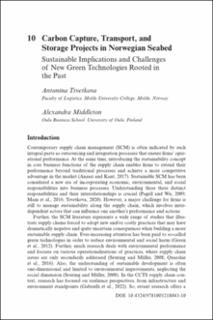| dc.contributor.author | Tsvetkova, Antonina | |
| dc.contributor.author | Middleton, Alexandra | |
| dc.date.accessioned | 2024-02-23T10:10:54Z | |
| dc.date.available | 2024-02-23T10:10:54Z | |
| dc.date.created | 2023-10-02T10:55:19Z | |
| dc.date.issued | 2023 | |
| dc.identifier.citation | Tsvetkova, Antonina; Middleton, Alexandra. Carbon capture, transport and storage projects in Norwegian seabed : sustainable implications and challenges of new green technologies rooted in the past. In: Supply chain operations in the arctic : implications for social sustainability, Antonina Tsvetkova, Konstantin Timoshenko (eds.), 223-247. Routledge | en_US |
| dc.identifier.isbn | 9781032110011 | |
| dc.identifier.uri | https://hdl.handle.net/11250/3119579 | |
| dc.description.abstract | The accumulation of greenhouse gases, more specifically carbon emissions, in the environment has resulted in severe health issues and climate change. Great efforts are being made to minimize the adverse effects of CO2 by using renewable energy sources and carbon capture technologies, with transport components and management of CO2 supply chains constituting a breakthrough in developing climate-resilient carbon cycles. However, there is a critical need to analyze whether the effect is sustainable. This chapter explores how supply chain management facilitates the implementation and further institutionalization of the world’s sustainable and climate strategies in the North Sea, with subsequent application in the Arctic Ocean. Data from eight semi-structured interviews and archival materials were analyzed in terms of the economic, environmental, and social aspects of sustainable development. The findings revealed that international and European law are not yet prepared to accept CO2 transit by ship. However, the effect of huge political pressure reflects what has been politically feasible, not what is desirable from a sustainability point of view. Substantial investments have been channeled into carbon capture, transport, and storage (CCTS) projects that include infrastructure construction, e.g., piping and terminals, but, at the same time, there is growing concern about the negative environmental and social impacts of CCTS projects on coastal communities and Indigenous Peoples. The chapter also addresses a number of the legal and commercial challenges CCTS projects in Norway have to overcome in response to political ambitions. Further, social “values and attitudes” are highlighted as factors that can be significant for the acceptance and further development of carbon capture, transport, and storage projects. The study provides an understanding of how new supply chain practices emerge by responding to political ambitions and institutional factors. | en_US |
| dc.language.iso | eng | en_US |
| dc.publisher | Routledge | en_US |
| dc.relation.ispartof | Supply chain operations in the arctic : implications for social sustainability | |
| dc.relation.uri | https://www.taylorfrancis.com/chapters/oa-edit/10.4324/9781003218043-10/ | |
| dc.rights | Attribution-NonCommercial-NoDerivatives 4.0 Internasjonal | * |
| dc.rights.uri | http://creativecommons.org/licenses/by-nc-nd/4.0/deed.no | * |
| dc.title | Carbon capture, transport and storage projects in Norwegian seabed : sustainable implications and challenges of new green technologies rooted in the past | en_US |
| dc.type | Chapter | en_US |
| dc.description.version | publishedVersion | en_US |
| dc.source.pagenumber | 223-247 | en_US |
| dc.identifier.cristin | 2180868 | |
| cristin.ispublished | true | |
| cristin.fulltext | original | |
| cristin.qualitycode | 2 | |

